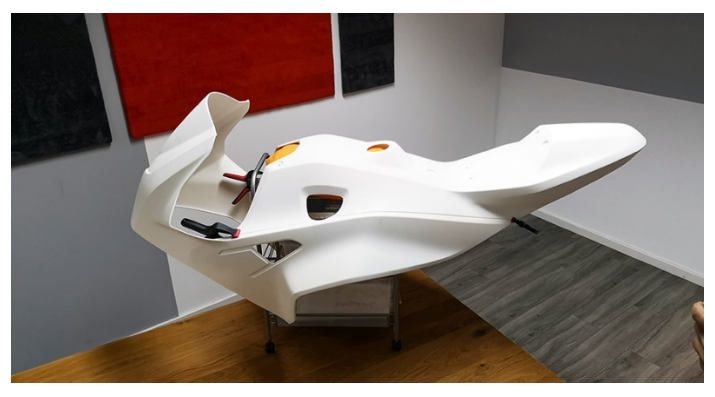relyon plasma GmbH, a subsidiary of TDK Electronics, is no stranger to the rigors involved in 3D printing for industrial functionality. As companies around the world rely on components that are often more affordable, ultimately, but also expected to be stronger and lighter in weight for better performance, challenges arise in the fabrication of multiple parts that must be sealed together in post-processing. Both relyon, headquartered in Regensburg, Germany, and Creabis GmbH, headquartered in Kirchheim, are working on adhesion solutions—now collaborating regarding plasma bonding and activation.
 The development team at Creabis has encountered issues in creating large 3D printed parts with complex geometries, often finding it necessary to 3D print multiple pieces to create one part as the build volume on a conventional 3D printer may be somewhat limited in terms of more sizeable projects.
The development team at Creabis has encountered issues in creating large 3D printed parts with complex geometries, often finding it necessary to 3D print multiple pieces to create one part as the build volume on a conventional 3D printer may be somewhat limited in terms of more sizeable projects.
As separate parts must be connected somehow later—usually by gluing—reliability is critical. As the relyon team points out in their press release, bonding strength must be comprehensive for long narrow joints 3D printed with very little bonding surface available.
“This weakness of 3D printing is in turn the strength of the plasma technology of relyon plasma GmbH,” states the company in their recent press release.
With proper ‘surface functionalization,’ both relyon and Creabis have discovered ‘significant improvement’ in adhesion. This process requires the user the wipe the surface clean first, removing any contaminants and allowing for better wettability while using adhesive.
Relyon has developed a new device to aid in the second step, with the piezobrush® PZ2—a handheld plasma device that they promise is easy to use with relatively little training or ‘special technical knowledge.’
The piezobrush® PZ2 aids in the preparation process, featuring a piezo plasma generator, the CeraPlas™, which can produce high voltage, creating cold atmospheric pressure plasma. The team at Creabis used the piezobrush with success while 3D printing, as they fabricated interior door trim for an electric car. They used two applications with the piezobrush, for four individual parts that were then activated with the cold plasma and superglued in places too. The Creabis team waited an hour and then applied further adhesive while parts were still in an activated state.

From left to right: Components of the inner door lining as individual parts, during plasma activation and after bonding.
“The use of the piezobrush® PZ2 now opens up possibilities for bonding individual parts that were previously unthinkable,” says Ralf Deuke, owner of Creabis GmbH.
In a second example, the Creabis team 3D printed a fairing for a motorbike meant for racing. The component required 12 individual parts to be glued together. In this case, they pre-treated the fairing with the piezobrush. The adhesive was so strong that the fairing can handle speeds over 200 km/h, with testing confirming that such parts have an adhesive bond three times stronger than others left untreated. The two companies look forward to 3D printing further and using the plasma technology in other parts, as their collaboration continues.
Precision, accuracy, and high-quality in parts manufactured for functional use is an ongoing concern for users and businesses introducing 3D printing technology into their normal processes. Adhesion is a common issue within 3D printing, and users on every level are continuing to work on solutions, whether they are engineers, researchers, or makers working from the desktop—emerging with improvements for interlayer adhesion in parts for construction, cell adhesion with materials like silicone, and solutions in terms of hardware too, like heatbeds. Let us know your thoughts! Join the discussion of this and other 3D printing topics at 3DPrintBoard.com.
[Source / Images: relyon plasma]Subscribe to Our Email Newsletter
Stay up-to-date on all the latest news from the 3D printing industry and receive information and offers from third party vendors.
You May Also Like
Printing Money Episode 17: Recent 3D Printing Deals, with Alex Kingsbury
Printing Money is back with Episode 17! Our host, NewCap Partners‘ Danny Piper, is joined by Alex Kingsbury for this episode, so you can prepare yourself for smart coverage laced...
Insights from Cantor Fitzgerald on AM’s Q1 2024 Landscape
A recent survey by Cantor Fitzgerald sheds light on the persistent challenges within the additive manufacturing (AM) industry in the first quarter of 2024. Based on responses from 38 industry...
3D Printing Financials: Xometry’s Scaling up and Strong Start to 2024
Xometry (Nasdaq: XMTR) kicked off 2024 with strong results, boosting its marketplace and technology to new heights. Both revenue and gross margin soared, fueled by an expanding global network of...
3D Printing Financials: Desktop Metal Targets Recovery Amid Net Losses and Revenue Downturn
Despite facing a decline in revenue and the persistent challenges of a tight economic climate, Desktop Metal (NYSE: DM) is making strides toward operational efficiency. The first quarter of 2024...



































